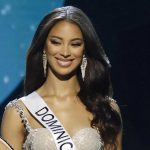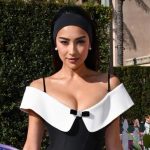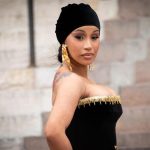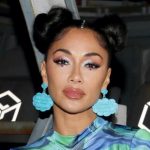

Last month, when a photo of Margot Robbie and Ryan Gosling appeared on the set of “Barbie,” the pair wore matching pink spandex and neon roller skates, drawing rapturous applause from the internet. There’s no denying the indulgence of the moment, a toy scene of ’80s nostalgia brought to life in two perfect actors.
Around the same time, Megan Fox and Machine Gun Kelly showed up at the premiere of the musician’s “Pink Life” Hulu documentary, with matching pink hair that was a veritable 2022 version of Barbie and Ken; she wore a rose cutout miniskirt, He was wearing a popcorn crop top and a pearl necklace.
In Rome, Valentino creative director Pierpaolo Piccioli wore a jaw-dropping look from the brand’s Fall ’22 ‘Pink PP’ collection (the Paris Fashion Week runway show, available only in pink or all-black) for several celebrity friends. Anne Hathaway walked the Spanish Steps in an embellished mini dress and the tallest pink platform in her biggest fashion moment since “The Devil Wears Prada” 16 years ago.
And so began the official “Barbie Nucleus” movement, a fashion trend that seems to have taken over other summer trends this year (looking at you here, coastal grandma).
But the “Barbie Nucleus” pink isn’t entirely new. In fact, the color has a years-long trend arc that has permeated the fashion world since 2017.
Why 2017? Because on January 21, the day after Donald Trump took office as President of the United States, more than 470,000 participants took part in the Women’s March in Washington, D.C., a rally that drew nearly 5 million people in the United States and about 700 people around the world. thousands of participants.
Many of them wear pink knitted hats that face upwards. The homemade pink kitten hat has become a calling card for Trump-era feminists, a call and response to the president’s daunting “Catch Her Kitten” tape.


Pink cat hats may be a rare sight now, as many have been debating how the hat’s symbolism might exclude trans women, nonbinary people and women of color from its messages. But color is still there—designers, stylists, celebrities, and influencers alike have turned to hue subtly and steadily to convey a variety of messages, from boring fun to feminist rebellion—or even at the same time.
After looking back at all the ways color has prevailed, from the decade-long pink hair trend to the pink that Lady Gaga hit the Met Gala’s pink carpet in 2019, the “Barbie” presentation came as no surprise to all people are fascinated.
While it may be a coincidence, just days after the U.S. Supreme Court decided to overturn the 1973 Roe v. Wade precedent, the “Barbie” photo is ripe for interpretation. Robbie and Gosling’s Barbie and Ken read like a Rorschach test for today’s feminist or adversary.
One may find relief or solace in the totemic return of traditional feminine aesthetics, while others may find it salt in the wound of a progressive vision of women’s equality, a shattered vision of power trousers being replaced by “Stepford Wife” Sensual, Aesthetic and morality.


For others, it’s an opportunity to upend pink and everything it stands for, regaining the hue and breaking the twin monoliths of goofy teenage girls and brash, man-thinking feminists.
Pink is now an equal-opportunity color, a choose-your-own-adventure shade that may help break down stereotypes about women and serve as clothing armor in the fight for women’s equality and a new era of feminism.
The evolution of pink
Pink is not always designated as a feminine color. In the late 1800s and early 1900s, parents wore pink (and dresses, since the dress was considered unisex until age 6 or 7) for little boys and blue for little girls.
According to a 1918 article in the trade publication Earnshaw Babies, “The generally accepted rule is that boys wear pink and girls blue. The reason is that pink is a more sedate color and is more suitable for boys, while blue, more delicate , more suitable for girls.”

First Lady Mamie Eisenhower looks at her own oil painting, a gift for her 60th birthday, in the White House Library in Washington, D.C., on November 14, 1956. In the portrait, the first lady is dressed at the inaugural ball. Credit: Associated Press
Some historians, such as Jo Paoletti, author of “Pink and Blue: Telling Boys and Girls in America,” attribute the girl’s shift to pink to manufacturers’ marketing strategies starting in the 1940s. Others took First Lady Mamie Eisenhower’s 1953 presidential inauguration gown, a massive pale pink tulle and rhinestone-encrusted ball gown with matching opera gloves and handbag, as a pink twist . The 1957 movie “Funny Faces” starring Audrey Hepburn included a song called “Think Pink,” in which the fictional magazine staff marketed the bubblegum hue as the ultimate symbol of femininity, motherhood, grace and taste. . It further cements the ultra-feminine connotation of color that has been around for the past six decades. 
Actress Kay Thompson (center) in 1957’s “Funny Face” for the film’s “Think Pink” scene. Credit: Courtesy Everett Collection
The original Barbie didn’t wear pink; instead, she donned a black-and-white striped swimsuit and white sunglasses. While a selection of Barbie dolls from the 60s showcased the doll’s color (and lots of red), it wasn’t until the late 70s that Barbie’s pink became her signature, when “Superstar Barbie” wore a dramatic pink evening gown, she With blue eyes, platinum blonde hair, and body proportions that are anatomically impossible, this look will define beauty ideals and aspirations for decades to come.

Barbie Dreamhouse experience in Berlin, Germany, 2013. Image credit: Getty Images
During the 2000s and 2010s, Mattel came together to create a more diverse and inclusive Barbie world. In 2005, Destiny’s Child Barbies launched Beyoncé Barbie, and in 2015, the brand launched Barbie’s “Sheroes” line, which featured real-life women like Zendaya, Eva Chen and Ava DuVernay.
In 2016, Barbie underwent a body transformation, and Mattel introduced three new lifelike body shapes for the doll. Mattel also has an ongoing Barbie Women’s Inspiration collection that turns real-life women like Rosa Parks, Frida Kahlo and Amelia Earhart into dolls; this month Earlier, they launched the Jane Goodall doll.
The toy brand may have done some work in redefining some of Barbie’s beauty stereotypes — from Aqua’s 1997 hit “Barbie Girl” to Reese Witherspoon in the “Legal Blonde” movie franchise.
But much of the recent redefinition of the doll’s iconic hues has come from marginalized groups outside the world of children’s toys. Since then, women of color, transgender people, drag queens and other groups have embraced the concept of pink as a beauty standard and claimed to own the color. Notable male celebrities have also helped dismantle the notion of pink as a color for cisgender white women, with everyone from Jason Momoa and Sebastian Stan to Jake Gyllenhaal flaunting the hue on the red carpet.

Trixie Mattel celebrates Pride on June 9 at the Tribeca Music Festival in New York. Drag queens helped redefine pink as an inclusive aesthetic. Credit: Getty Images for Warner Bros. Dee
Cis women have also joined the cause of subverting the hues that once tried to define them. TikTok’s #Bimbotok has become a conduit for criticism and redefinition of feminism, making fun of the hyper-feminine “bimbo” stereotype while also offering social and political commentary on the rigid box women are often placed in.
In front of an audience of about 4.6 million, TikTok star and comedian Chrissy Chlapecka satirically portrayed a burlesque blonde in a miniskirt, bra and thigh-high boots, while throwing light on sex positivity and protecting women’s bodies autonomy. The sarcastic commentary — and its sarcastic but perhaps serious aesthetic — parallels the hyperfemininity of more conservative circles, a clever inversion that might eschew echo chambers and algorithms for more groupthink How to redefine feminism.
“Honestly, I think I wake up very brave every day and I’m determined to look like a slut,” Chlapecka said in one of her recent videos, sporting a Valley Girl accent, pink hair and matching outfits . “This miniskirt? My battle suit. This top? That’s my armor, okay? Who am I protecting? Girly, gay, all my darlings. This cat’s America,” she concluded.
I’m here to protect the girl! #slay
♬ original sound – chrissy
A look at the Barbiecore fashion that’s resonating elsewhere on social media is proof that today’s pink suits are by no means submissive, but leaning toward edgy, aggressive, and maybe even a little punk. The revival of the Millennium Bug encouraged Paris Hilton-like cosplay. Mini dresses, short skirts, crop tops, platform shoes and stilettos are dominated by pink, with fashion and sexiness as weapons.










